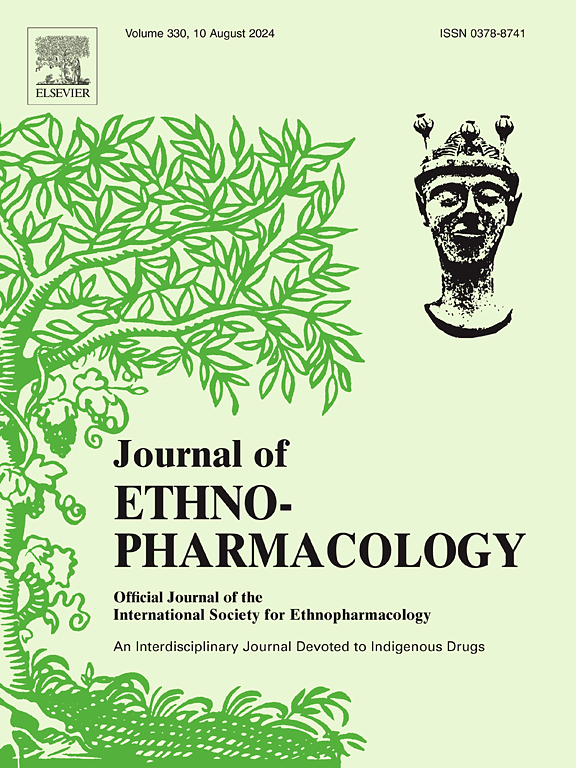Pharmacological effects and mechanisms of alkamides DDA-E and DDA-Z from Asari Radix et Rhizoma in migraine: Insights from serum pharmacochemistry, network pharmacology, and experimental validation
IF 4.8
2区 医学
Q1 CHEMISTRY, MEDICINAL
引用次数: 0
Abstract
Ethnopharmacological relevance
Asari Radix et Rhizoma (ARR), a traditional Chinese medicine, has been used for centuries to treat various diseases, including migraine, rheumatic pain, and toothache. Valued for its capacity to warm the meridians and promote dispersion, ARR is regarded as an essential herb for releasing the exterior, dispelling cold, and alleviating pain. Alkamides, represented by N-isobutyl-2E,4E,8Z,10E/Z-dodecatetraenamide (DDA-E/Z), were considered closely related to traditional properties of ARR and exhibited diverse biological activities. However, their underlying anti-migraine mechanisms remain unclear.
Aim of the study
This study aimed to identify the active constituents of ARR and investigate the pharmacological effects and mechanisms of ARR-derived alkamides DDA-E and DDA-Z in migraine models through integrated network pharmacology and experimental validation.
Material and methods
The chemical profile and blood entry components of ARR were analyzed by ultra-high performance liquid chromatography-quadruple time-of-flight mass spectrometry (UHPLC-Q/TOF-MS). Network pharmacology was used to identify potential targets and pathways associated with the prototypical plasma components in migraine. Analgesic and anti-inflammatory activities of the key active ingredients, DDA-E, DDA-Z and their combinations, were assessed using behavioral tests and periorbital mechanical pain thresholds. Hematoxylin and eosin, immunofluorescence analysis, enzyme-linked immunosorbent assay, Westen blot, and real-time quantitative reverse transcription PCR were conducted to explore underlying mechanisms. Functional assay and molecular docking studies investigated the ability of DDA-E and DDA-Z to activate CB1/CB2 receptors.
Results
A total of 35 components were identified in ARR, with 10 of them entering the blood as prototypes. Network pharmacology revealed 209 potential targets of ARR-derived prototypical blood-entry components in migraine. DDA-E and DDA-Z showed high plasma exposure and the highest degree values in the network analysis, indicating their roles as important active ingredients of ARR for migraine. The in vitro and in vivo experiments suggested that the potential targets of DDA-E were CGRP, ERK, and AKT, which mainly acted through cAMP and PI3K-Akt pathways, while DDA-Z targeted COX-2, MAPK, and AKT through MAPK and PI3K-Akt pathways. Immunofluorescence, functional assays, and molecular docking results confirmed that DDA-E and DDA-Z tend to selectively activate CB1/CB2 receptors.
Conclusion
In this study, serum pharmacochemistry combined with network pharmacology identified DDA-E and DDA-Z as the key active constituents of ARR. Subsequent experimental validation elucidated their potential anti-migraine mechanisms, highlighting their selective activation of cannabinoid receptors and providing a foundation for further research and therapeutic application.
细辛中碱胺DDA-E和DDA-Z对偏头痛的药理作用及其机制:来自血清药物化学、网络药理学和实验验证的见解
民族药理学相关性:细辛根茎(ARR)是一种传统中药,几个世纪以来一直用于治疗各种疾病,包括偏头痛、风湿痛和牙痛。ARR因其温暖经络和促进弥散的能力而受到重视,被认为是一种释放外部,驱寒和减轻疼痛的重要草药。以n -异丁基- 2e、4E、8Z、10E/Z-十二烷基酰胺(DDA-E/Z)为代表的烷酰胺类化合物被认为与ARR的传统性质密切相关,具有多种生物活性。然而,它们潜在的抗偏头痛机制尚不清楚。研究目的:本研究旨在通过综合网络药理学和实验验证,鉴定ARR的有效成分,探讨ARR衍生的烷酰胺DDA-E和DDA-Z对偏头痛模型的药理作用和机制。材料与方法:采用超高效液相色谱-四倍飞行时间质谱(UHPLC-Q/TOF-MS)分析ARR的化学特征和血液进入成分。网络药理学用于确定偏头痛中与原型血浆成分相关的潜在靶点和途径。采用行为学测试和眶周机械性疼痛阈值评估关键活性成分DDA-E、DDA-Z及其组合的镇痛和抗炎活性。通过苏木精和伊红、免疫荧光分析、酶联免疫吸附试验、western blot和实时定量反转录PCR来探索其潜在机制。功能分析和分子对接研究探讨了DDA-E和DDA-Z激活CB1/CB2受体的能力。结果:ARR共鉴定出35种成分,其中10种作为原型进入血液。网络药理学揭示了偏头痛中arr衍生的原型血液进入成分的209个潜在靶点。DDA-E和DDA-Z在网络分析中表现出较高的血浆暴露度和最高的度值,表明它们是偏头痛ARR的重要活性成分。体外和体内实验表明,DDA-E的潜在靶点是CGRP、ERK和AKT,主要通过cAMP和PI3K-Akt通路起作用,而DDA-Z则通过MAPK和PI3K-Akt通路作用于COX-2、MAPK和AKT。免疫荧光、功能分析和分子对接结果证实,DDA-E和DDA-Z倾向于选择性激活CB1/CB2受体。结论:本研究通过血清药物化学结合网络药理学鉴定出DDA-E和DDA-Z是ARR的关键活性成分。随后的实验验证阐明了它们潜在的抗偏头痛机制,突出了它们对大麻素受体的选择性激活,为进一步的研究和治疗应用奠定了基础。
本文章由计算机程序翻译,如有差异,请以英文原文为准。
求助全文
约1分钟内获得全文
求助全文
来源期刊

Journal of ethnopharmacology
医学-全科医学与补充医学
CiteScore
10.30
自引率
5.60%
发文量
967
审稿时长
77 days
期刊介绍:
The Journal of Ethnopharmacology is dedicated to the exchange of information and understandings about people''s use of plants, fungi, animals, microorganisms and minerals and their biological and pharmacological effects based on the principles established through international conventions. Early people confronted with illness and disease, discovered a wealth of useful therapeutic agents in the plant and animal kingdoms. The empirical knowledge of these medicinal substances and their toxic potential was passed on by oral tradition and sometimes recorded in herbals and other texts on materia medica. Many valuable drugs of today (e.g., atropine, ephedrine, tubocurarine, digoxin, reserpine) came into use through the study of indigenous remedies. Chemists continue to use plant-derived drugs (e.g., morphine, taxol, physostigmine, quinidine, emetine) as prototypes in their attempts to develop more effective and less toxic medicinals.
 求助内容:
求助内容: 应助结果提醒方式:
应助结果提醒方式:


